Boston Pizza Pizzaburger
Events, Seasonal and Short-Term (BRONZE)
Client Credits: Boston Pizza International
Steve Silverstone, EVP, Marketing
Joanne Forrester, VP, Marketing
James Kawalecki, Marketing Manager
Agency Credits: TAXI Canada Ltd.
Darren Clarke, Executive Creative Director
Niall Kelly, Creative Director
Niall Kelly, Scott Johnson, Art Directors
Darren Clarke, Jono Holmes & Geoff Morgan, Writers
Brooke Hennessy & Niall Kelly, Designers
Edith Rosa, Group Account Director
Anna Halfpenny, Account Director
Natalie Street, Account Manager
Sean McDonald, Planner
Cynthia Heyd, VP, Integrated Production
Winnie Alfred, Broadcast Producer
Sharon Govang, Print Producer
Sonja Vreugdenburg, Interactive Producer
David Palumbo, Illustrator
Andrew O’Driscoll, Retouching
PHD, MEDIA
High Road Communications, PR
Section I — BASIC INFORMATION
| Business Results Period (Consecutive Months): | April–May 2013 |
| Start of Advertising/Communication Effort: | April 1, 2013 |
| Base Period as a Benchmark: | April–May 2012 |
Section II — SITUATION ANALYSIS
a) Overall Assessment
Executive Summary:
This case study outlines the successful launch of Boston Pizza’s new product innovation, the Pizzaburger. This launch was the most successful new product introduction in Boston Pizza’s history. What fuelled its success? A unique and innovative product that not only tasted great, but when combined with a compellingly entertaining creative idea, it generated immediate awareness and drove purchase at record velocity.
Overall Assessment:
In recent years, to help deliver food news and drive the customers to the door during the crucial NHL playoffs season, BP focused on improving their dude-friendly sports-bar-type menu items. It started in 2011 with their wings, which resulted in a 160% sales growth versus the previous year. Then in 2012, BP introduced boneless chicken wings, but branded them as ALL MEAT WINGS, resulting in increased sales of 54.7% over the previous year.
With this success, coming out of 2011 and 2012, there was great pressure for BP to continue building momentum during the playoffs and to focus on a new menu item in 2013. The wing category had been conquered, and it was time to take on a new category – burgers. Although BP recognized that burgers were an important menu item, at the time, they were not a major player in the burger category, falling into a sea of sameness with their competitors. Guest awareness of BP’s burger quality was low and lagged behind their pizza, pasta, and now wings, so it was important to improve the product and gain credibility.
When the 2013 NHL playoffs season was fast approaching, BP upped the ante on previous years’ innovations by developing a truly epic product – the Pizzaburger. Not only was it a buzz-worthy bacon burger wrapped in a pepperoni pizza, but it was also an improvement on BP’s existing burger offerings. BP took two iconic sports bar menu items and made the ultimate playoffs hockey meal.
b) Resulting Business Objectives
Our challenge was to give the Pizzaburger the launch it deserved, one that would not only showcase this innovative culinary mash-up, but would also match the massive success of BP’s 2011 and 2012 NHL playoffs campaigns.
Additionally, the goal of this newest food innovation was to increase BP’s overall burger category sales by 50% from April to June 2013 versus 2012.
c) Annual Media Budget
$1 – $2 million
d) Geographic Area
English Canada
Section III — STRATEGIC THINKING
a) Analysis and Insight
We needed to speak to our current Boston Pizza customer. He’s the dad and dude aged 25 to 54 who comes in with his family on a weekday and is back with his buddies for a pint on Saturday night to watch the game. He is a big sports fan, and the NHL playoffs are the perfect reason to go to BP to catch the game, have a beer, and eat some great food. It’s been a long time since these guys have seen anything truly groundbreaking on a burger menu. After all, this is a category where toppings like chipotle ketchup and onion straws are considered newsworthy.
After looking at the burger’s competitive landscape, we realized that we were not only competing with our usual suspects in the casual dining restaurant category but with everyone, including quick-service restaurants and specialty burger shops that focus only on burgers. The category is saturated, but no one had a product quite like ours. This was a true food innovation. So we needed to find a way to break through the clutter within this category and launch the Pizzaburger in a big and memorable way.
When we started to think about the Pizzaburger, we knew we were creating a moment in food history. No one had ever introduced a bacon burger wrapped in a pepperoni pizza. It indicates a game-changing, unprecedented, revolutionary moment in food history. Frankly, we considered our target lucky to bear witness to it.
But not everyone is so lucky. What about our dude’s dad? His granddad? Hell, what about all the men who will never get to experience the Pizzaburger? We decided that the perfect way to launch the Pizzaburger would be to tap into our target’s sense of lineage and brotherhood and riff on the idea of the responsibility of carrying the torch for everyone who came before them.
b) Communication Strategy
Because of the nature of this food innovation, we wanted to make our dads and dudes feel a part of something historic. It wouldn’t be enough to just call it “new.” We had to create something far more emotional. Our consumers weren’t just buying a burger; they were biting into a piece of food history. We needed to create an emotional connection with our target.
We knew that timing was everything and that our target really likes sports, so the NHL playoffs was the perfect time to introduce our Pizzaburger. Sports bar traffic would be high, and we wanted a time frame when we were guaranteed a captive audience. This was critical, as hockey fans were not only tuning in to multiple games each week, but they were also deciding where to watch the games each week. The pressure to deliver a breakthrough campaign was heightened. We also knew that social media was important to our audience, and we wanted to find a way to ensure our communications spread through social and digital channels.
The campaign surrounded our dads and dudes at all touch points. We used television to generate awareness, POS to generate appetite appeal, digital media to drive to our online ordering site for trial, and social media to garner earned impressions. Additionally, PR was used to generate interest and excitement to help spread the word by handing out free Pizzaburgers from food trucks in key locations where our target would be.
Section IV — KEY EXECUTIONAL ELEMENTS
a)Media Used
The Pizzaburger campaign consisted of a nine-week TV buy, running from April to June 2013 and included 60-, 30-, and 15-second spots, with a heavy focus on the NHL playoffs schedule. TV was accompanied by in-store POS, Facebook, online banners driving to BostonPizza.com, online pre-roll, a YouTube presence, and Xbox media.
b)Creative Discussion
Eat one for all those who couldn’t.
In the past, BP successfully used third party endorsements to lend credibility to its food news. This time, we added a twist to those endorsements. It would not be just one guy, but many, and not just modern man, but early man, the Middle Ages man, and every man in between. We decided to let the men of the past encourage the men of today to try the new Pizzaburger in their honour.
The Pizzaburger campaign depicted men throughout history – a caveman, a peasant, a knight, a cowboy, and a Viking – struggling with their food choices, or lack thereof. The message was that they may not have had options then, but you do now. So do right by them and try BP’s new Pizzaburger.
TV
On television, the launch of the Pizzaburger was treated like a documentary-style film and included 60-, 30-, and 15-second spots. The spots showcased the men of the past, including the caveman, the peasant, the knight, the Viking, and the cowboy, urging the men of today to eat one in their honour.
(Please see Exhibits #1–5)

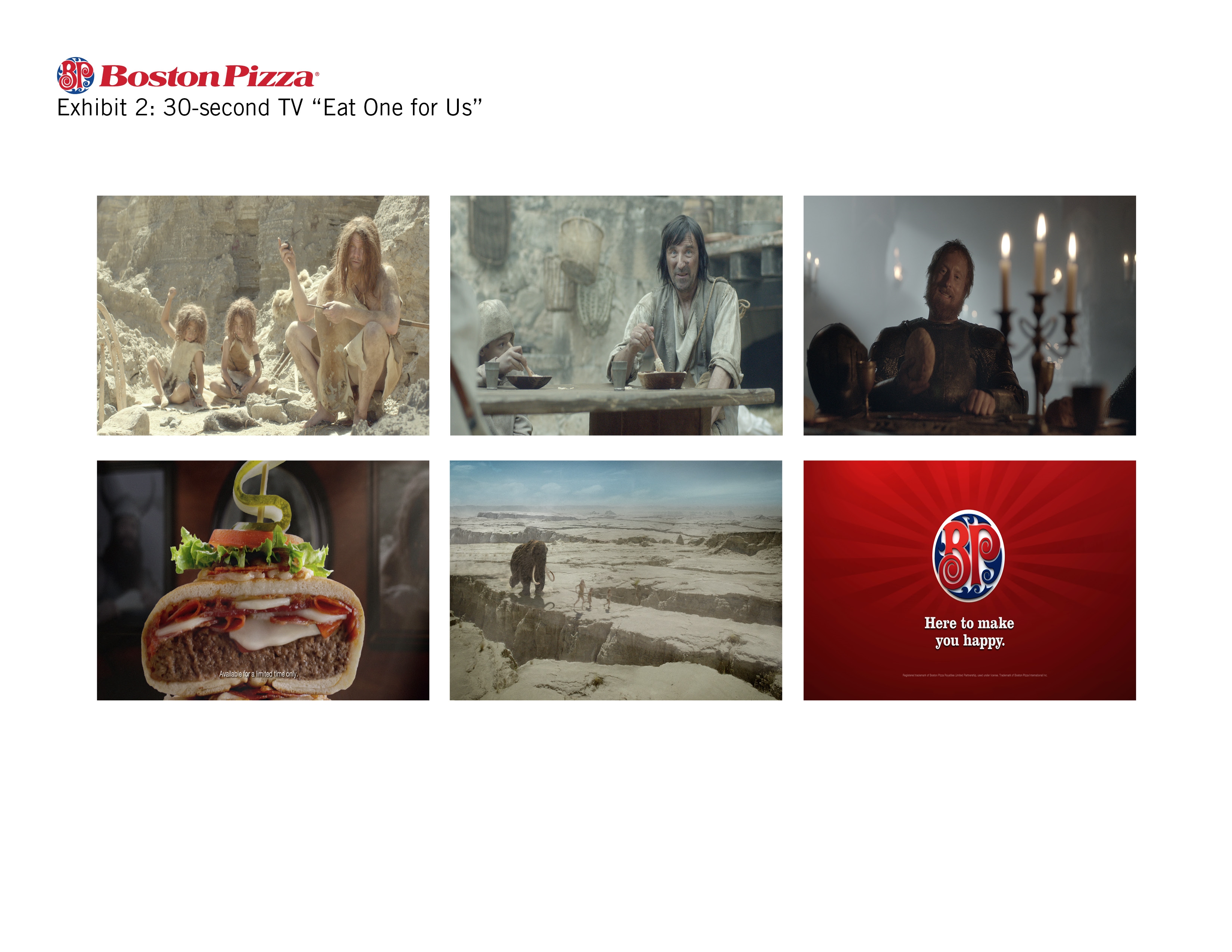

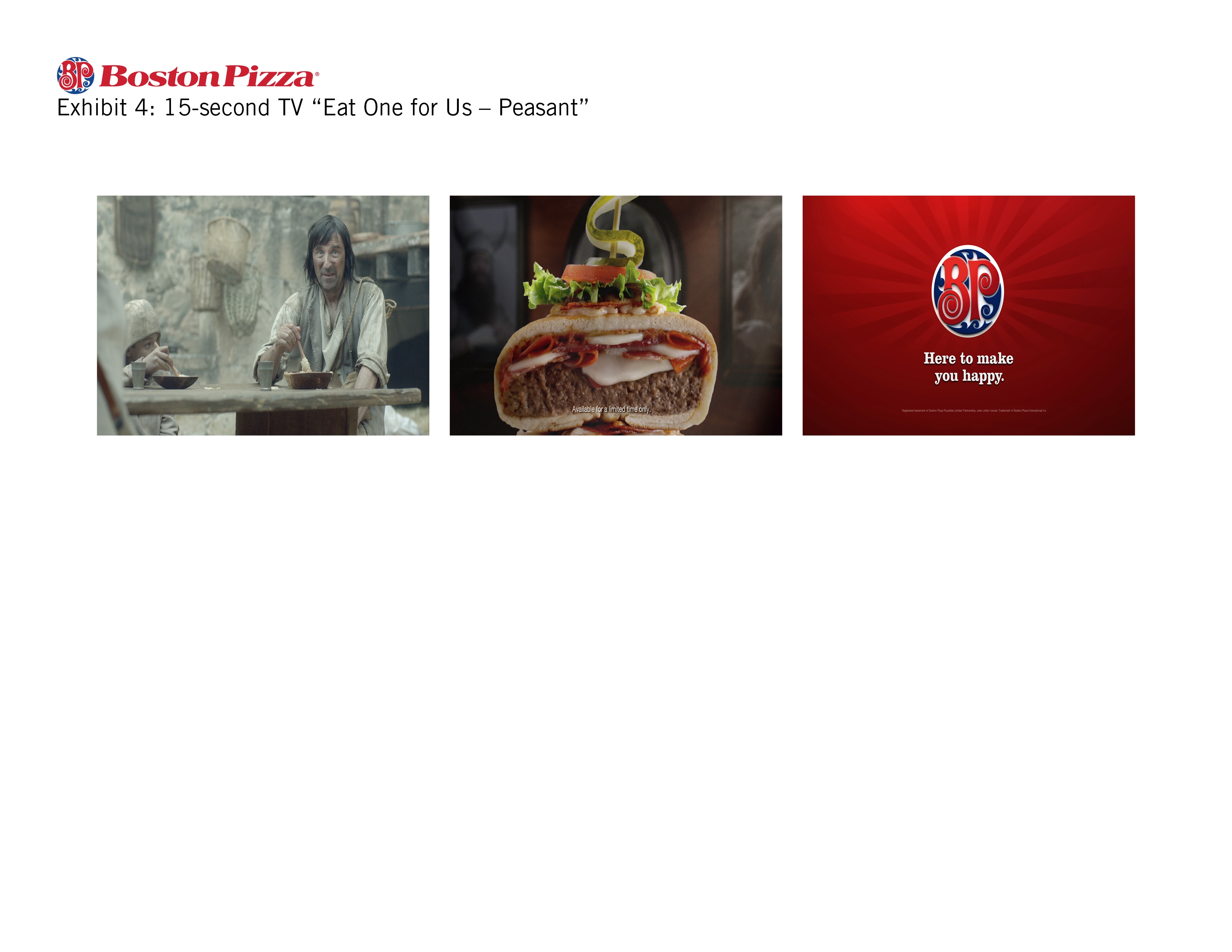
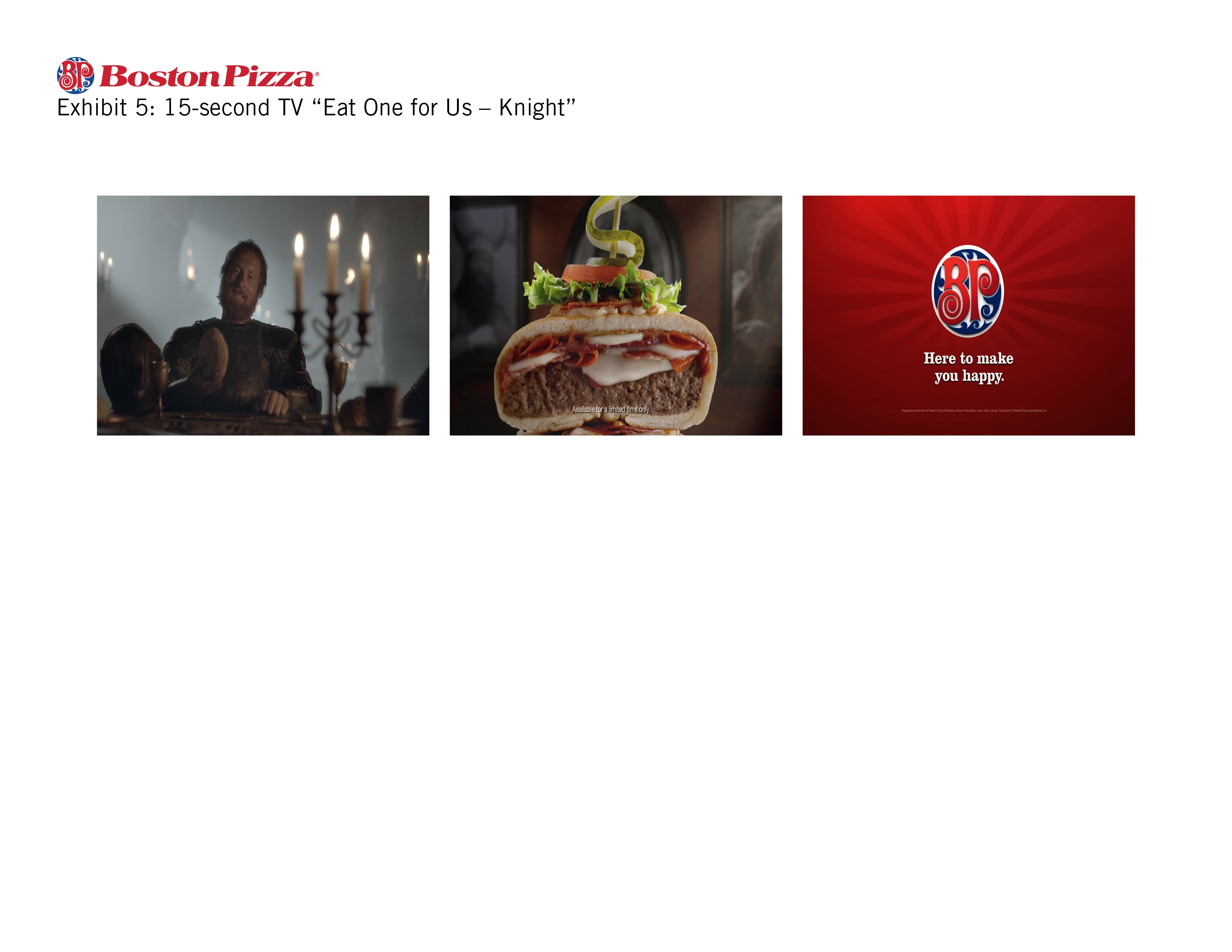
POS
A POS kit was delivered to restaurants. We leveraged these restaurant assets, including posters that featured the various characters and their pleas, collateral pieces, and an insert in the menu that included a #pizzaburger hashtag to encourage conversation about the product and campaign.
(Please see Exhibits #6–8)
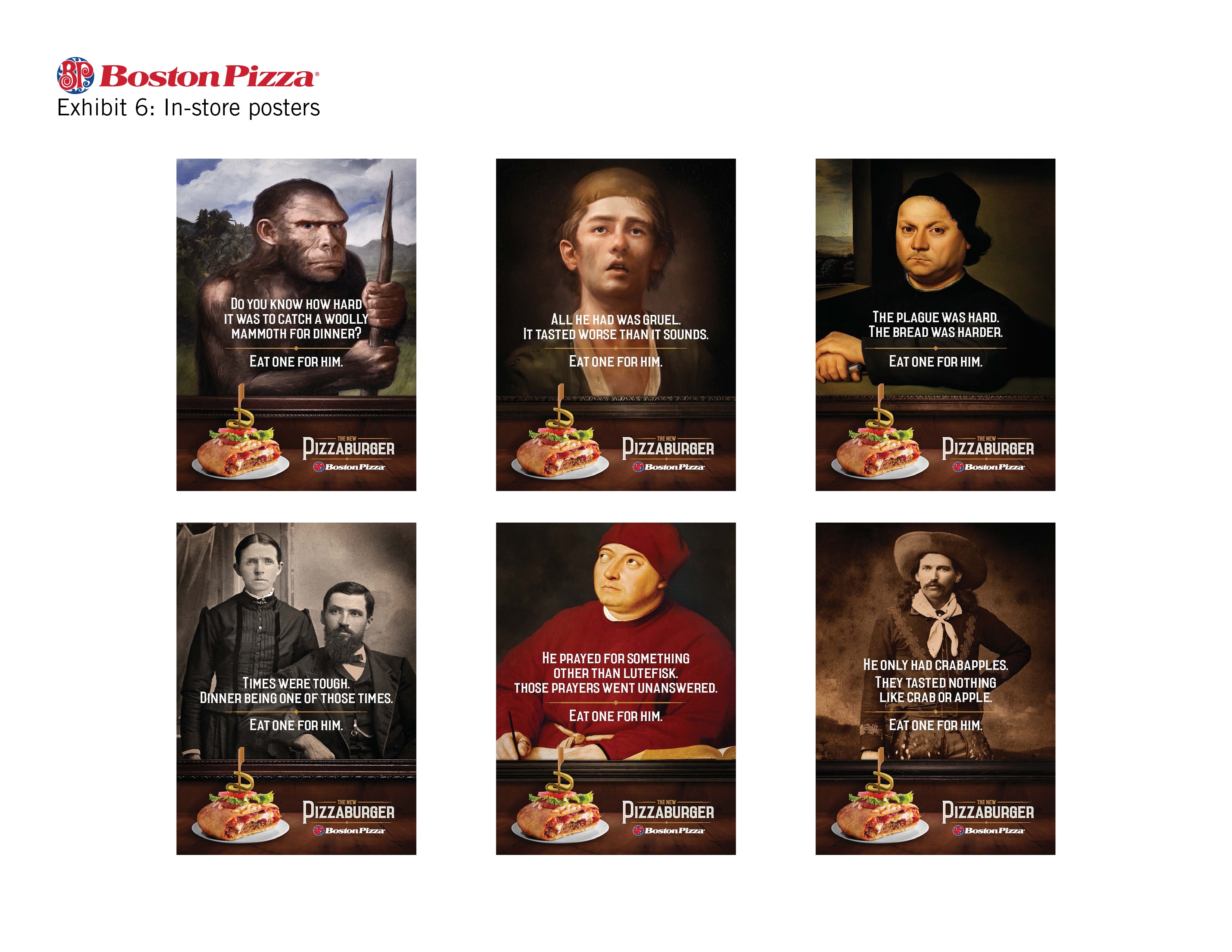
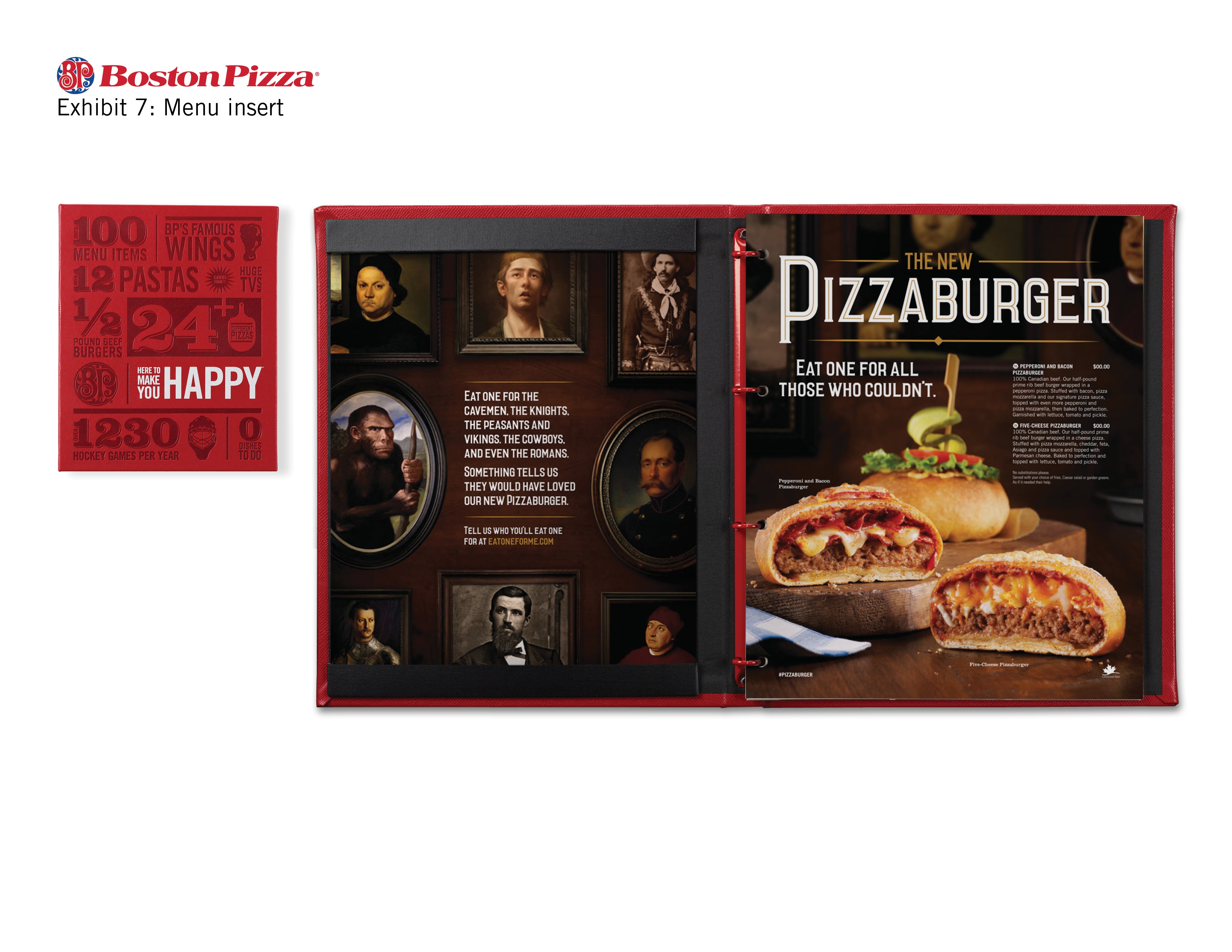
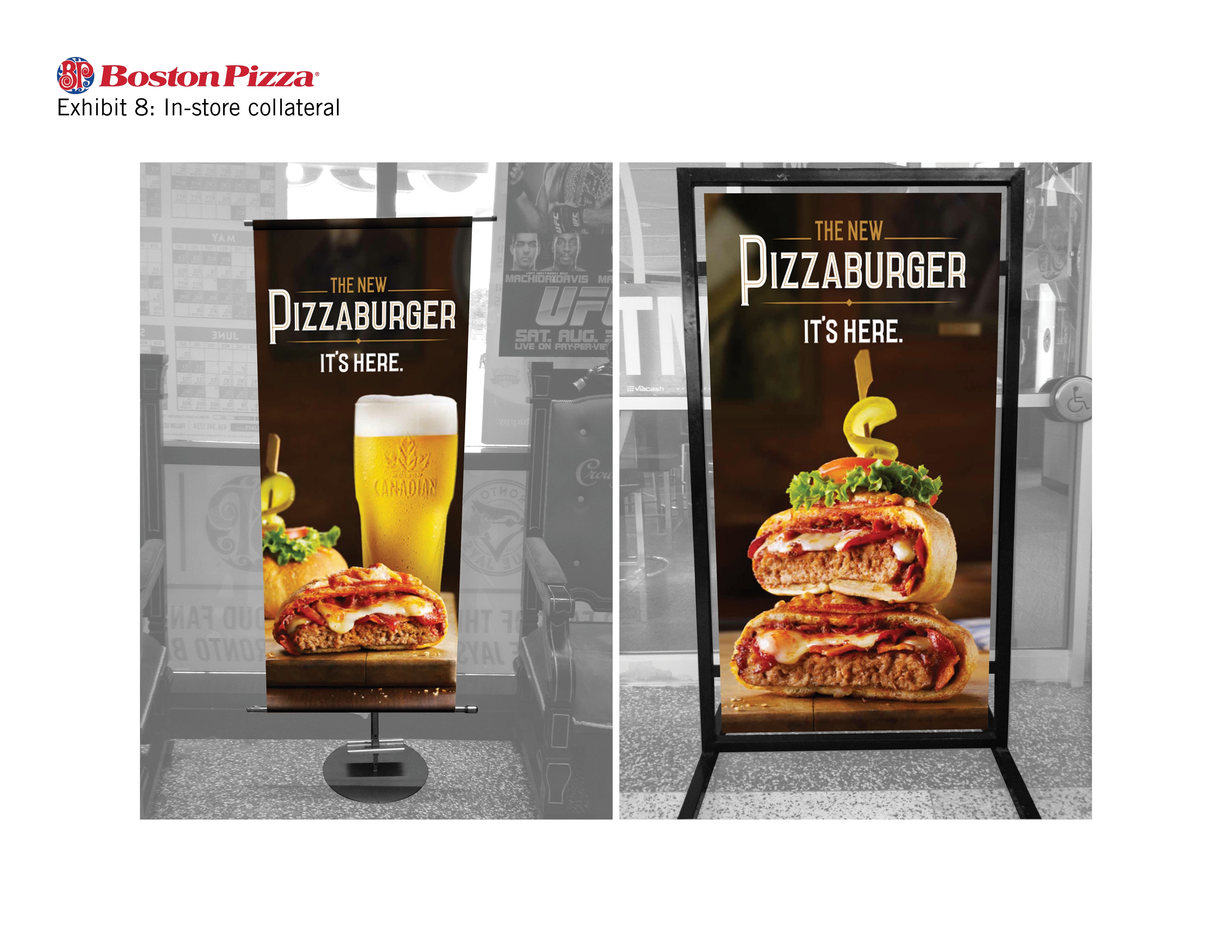
DIGITAL
Standard IAB banners also launched with a highly visible presence on sports-themed websites like TSN.com and NHL.com. The call to action on the banners was focused on trial, and the click-through took the user to a campaign-themed landing page at BostonPizza.com.
We also sent out a message to Boston Pizza’s over 400,000 newsletter subscribers to introduce the Pizzaburger and encourage online ordering purchases.
The Boston Pizza Facebook page featured a cover photo with the Pizzaburger image. Wall posts were used throughout the campaign to share detailed stories of each of the historical characters in whose honour we should eat one.
At BostonPizza.com, we had a campaign landing page that featured the TV spot and further product information. This site also allowed a guest to vote on which historical character they would like to “eat one for” and to share their vote via Facebook and Twitter. Lastly, the site included a Twitter feed that pulled in #pizzaburger tweets daily.
(Please see Exhibits #9–13)
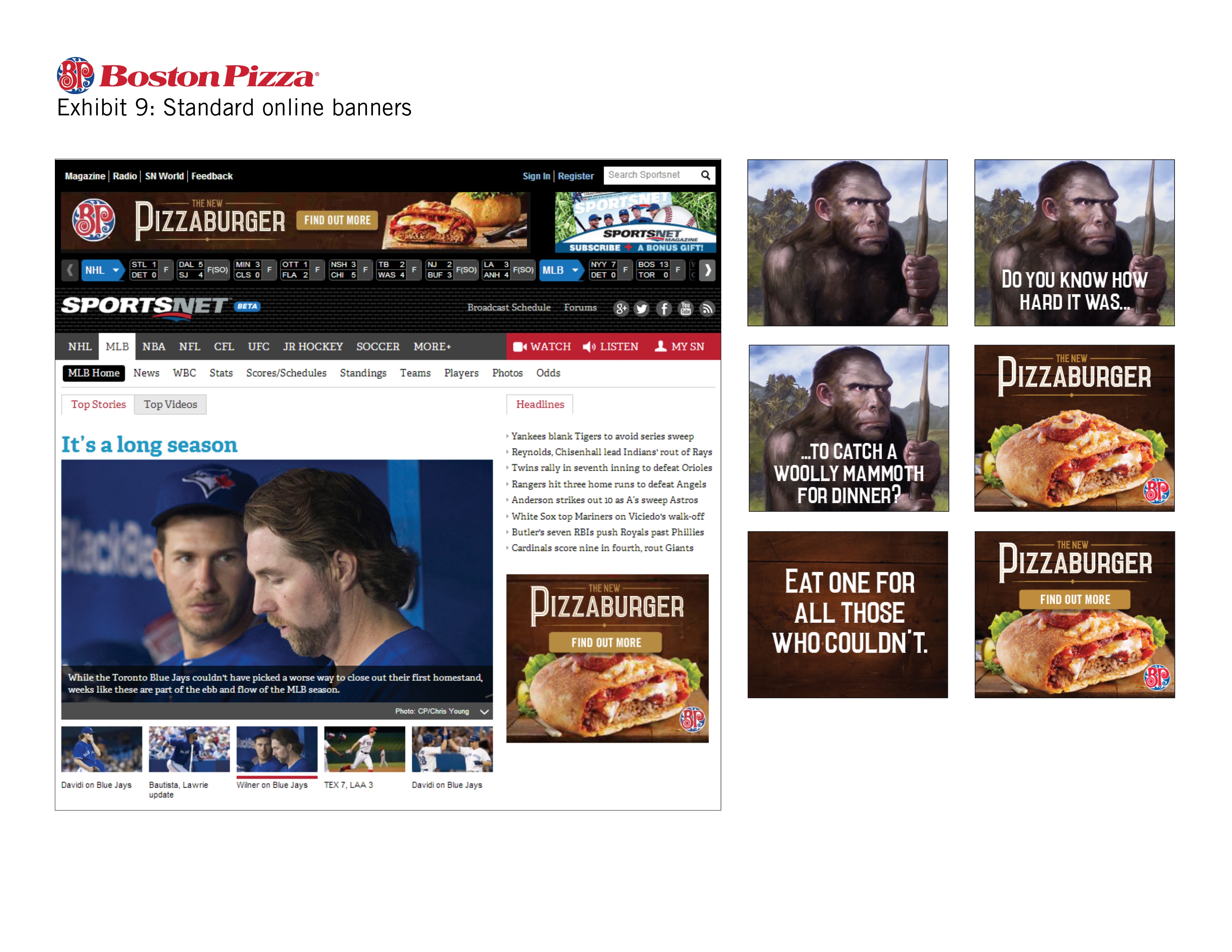
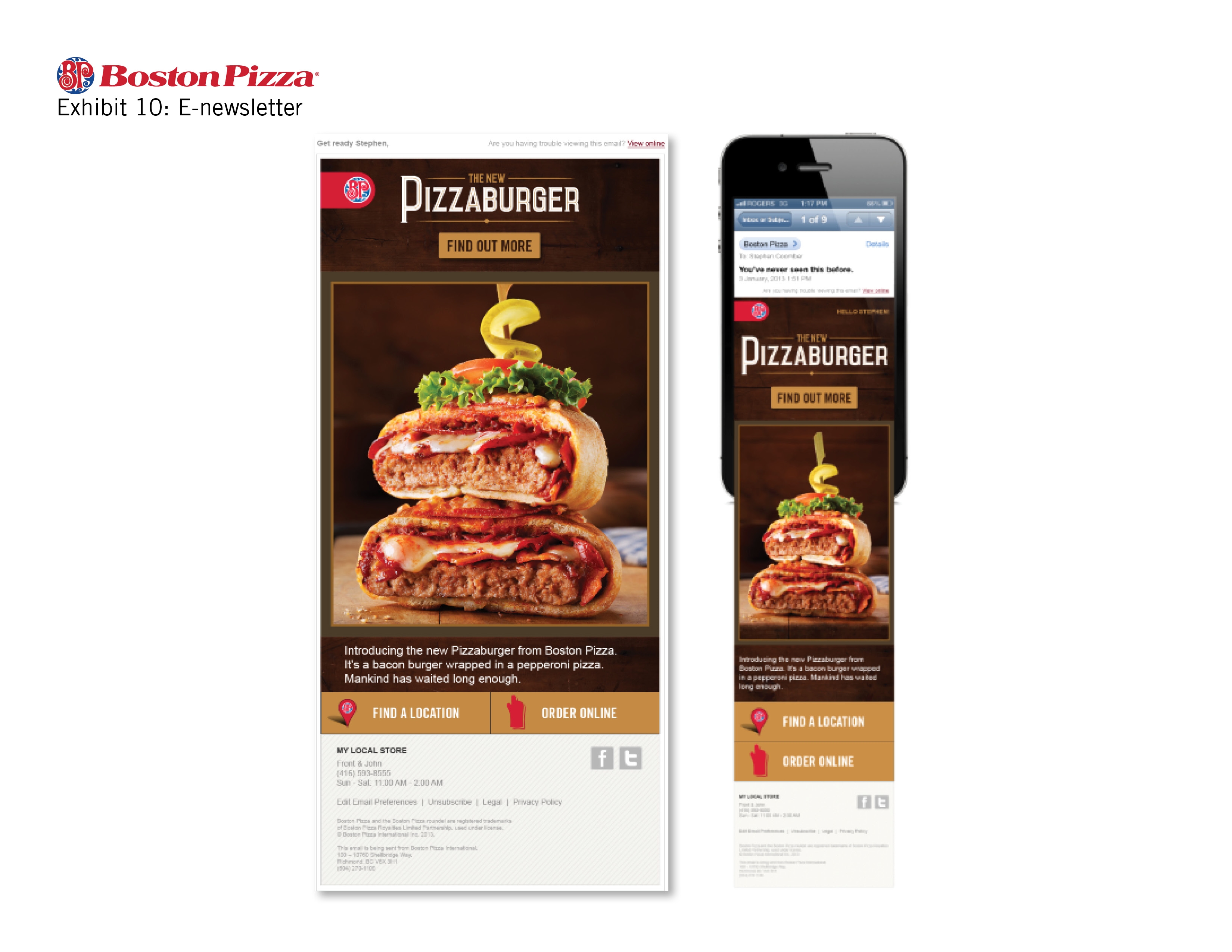


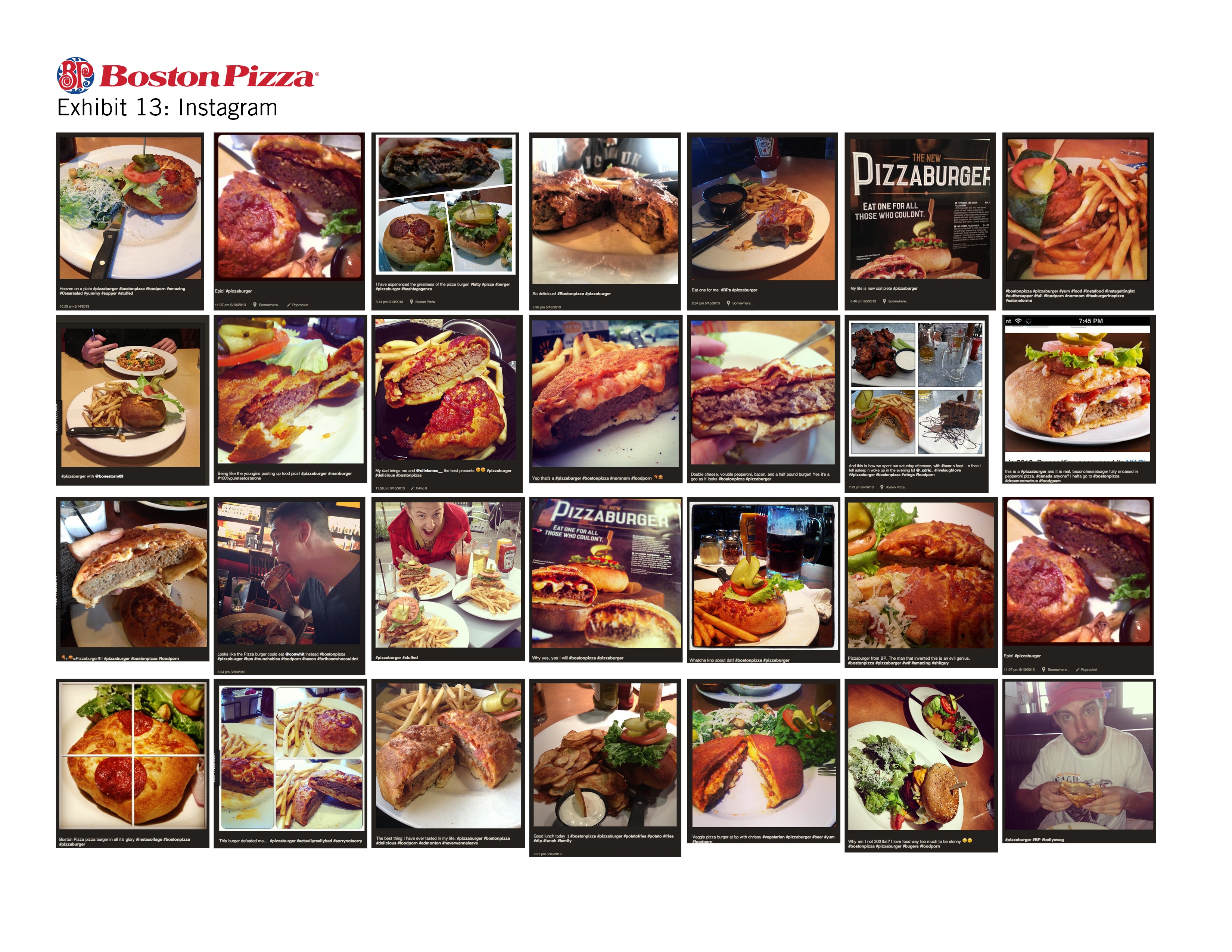
XBOX
An Xbox presence was also part of the digital media plan. Within the Xbox console, gamers could watch the 60-second spot, as well as see the add units and learn more about the Pizzaburger. Viewers could also vote and choose which of the characters they would eat a Pizzaburger for.
(Please see Exhibit #14)
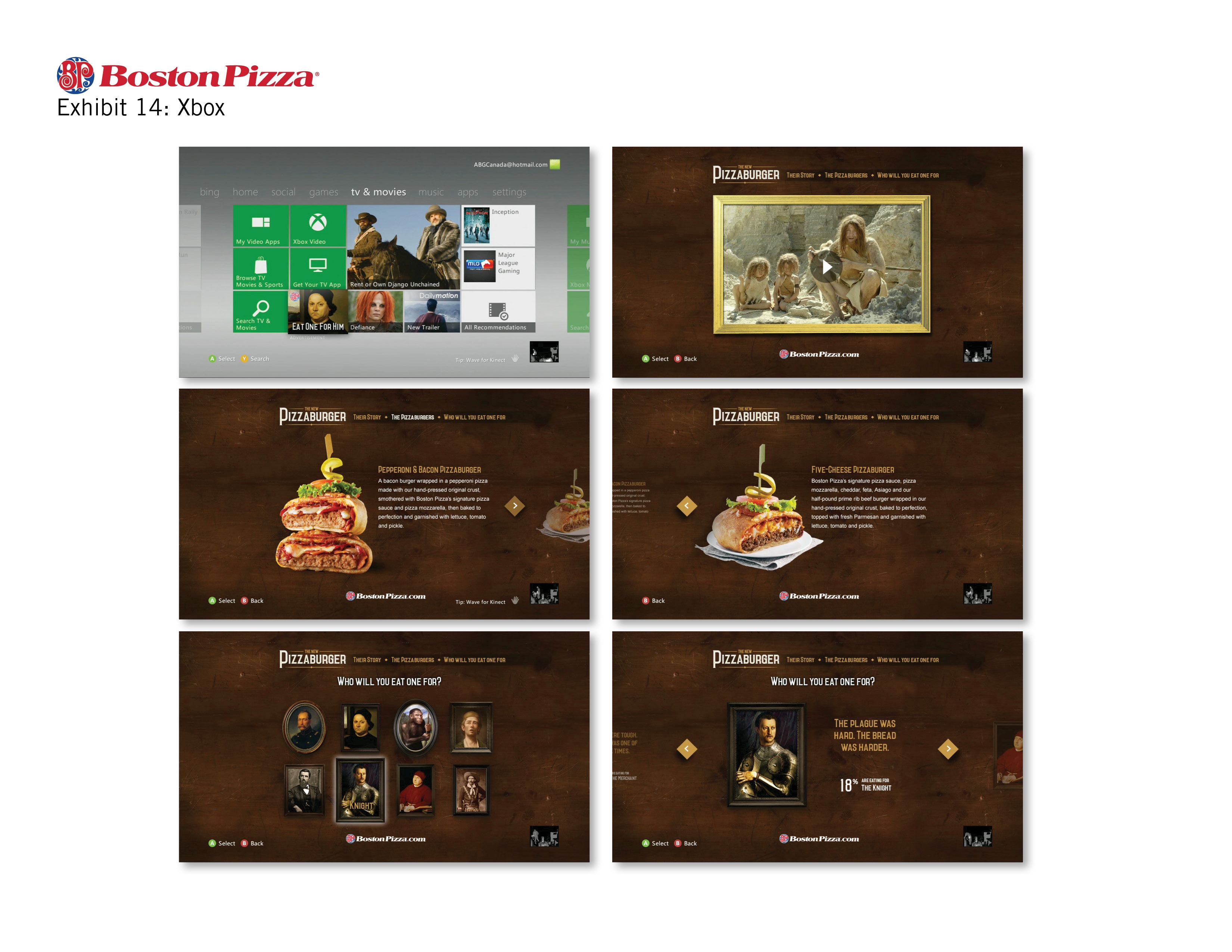
YOUTUBE
YouTube was used to increase communication of Boston Pizza’s new Pizzaburger.
(Please see Exhibit #15)
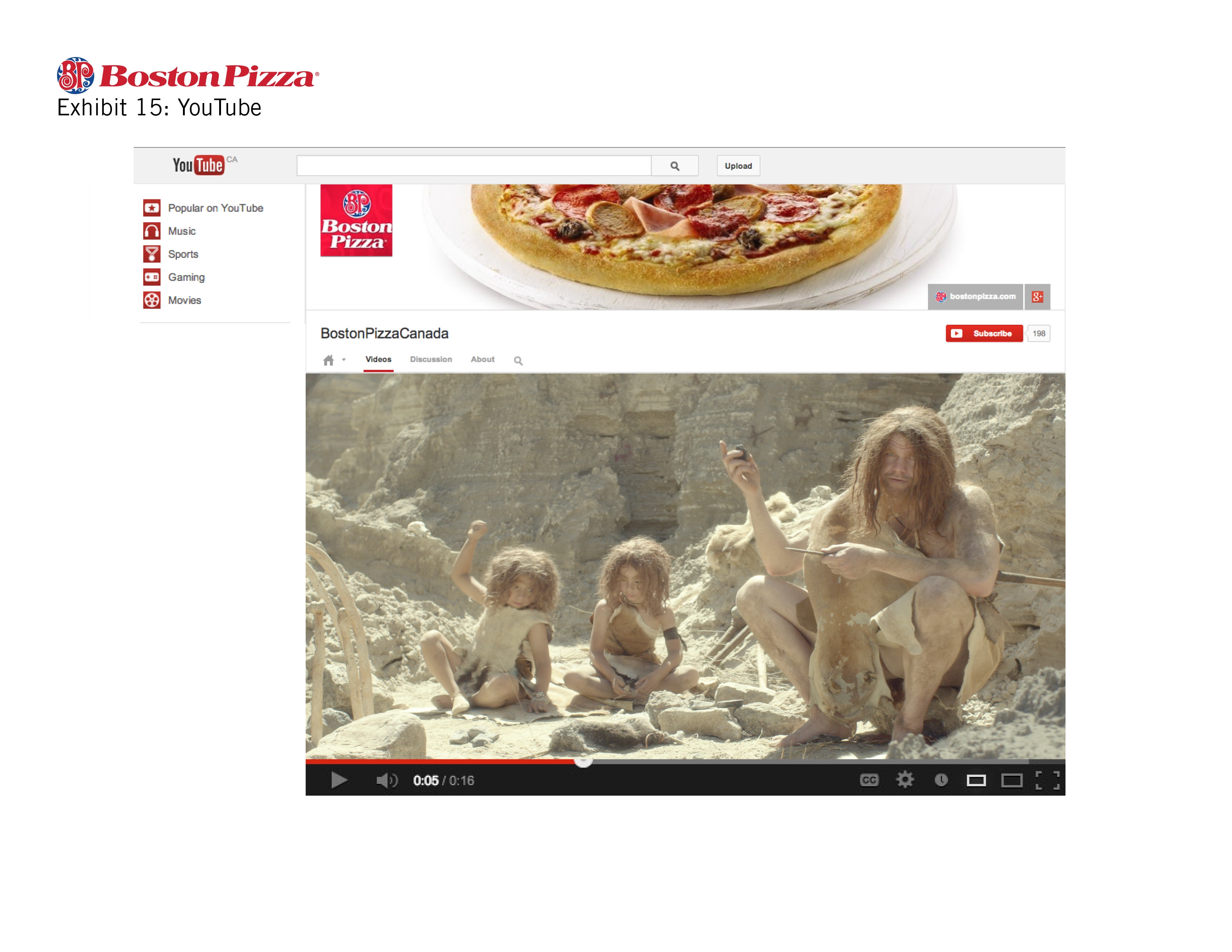
PR
Food trucks were used prior to the launch to create buzz and excitement. They were strategically placed, at unexpected times, in areas where the BP target would be.
SPORTS SPONSORSHIPS
NHL rink boards were redesigned to focus on the campaign with a single message promoting the #pizzaburger hashtag to create interest and encourage conversation about the product and campaign.
(Please see Exhibit #16)
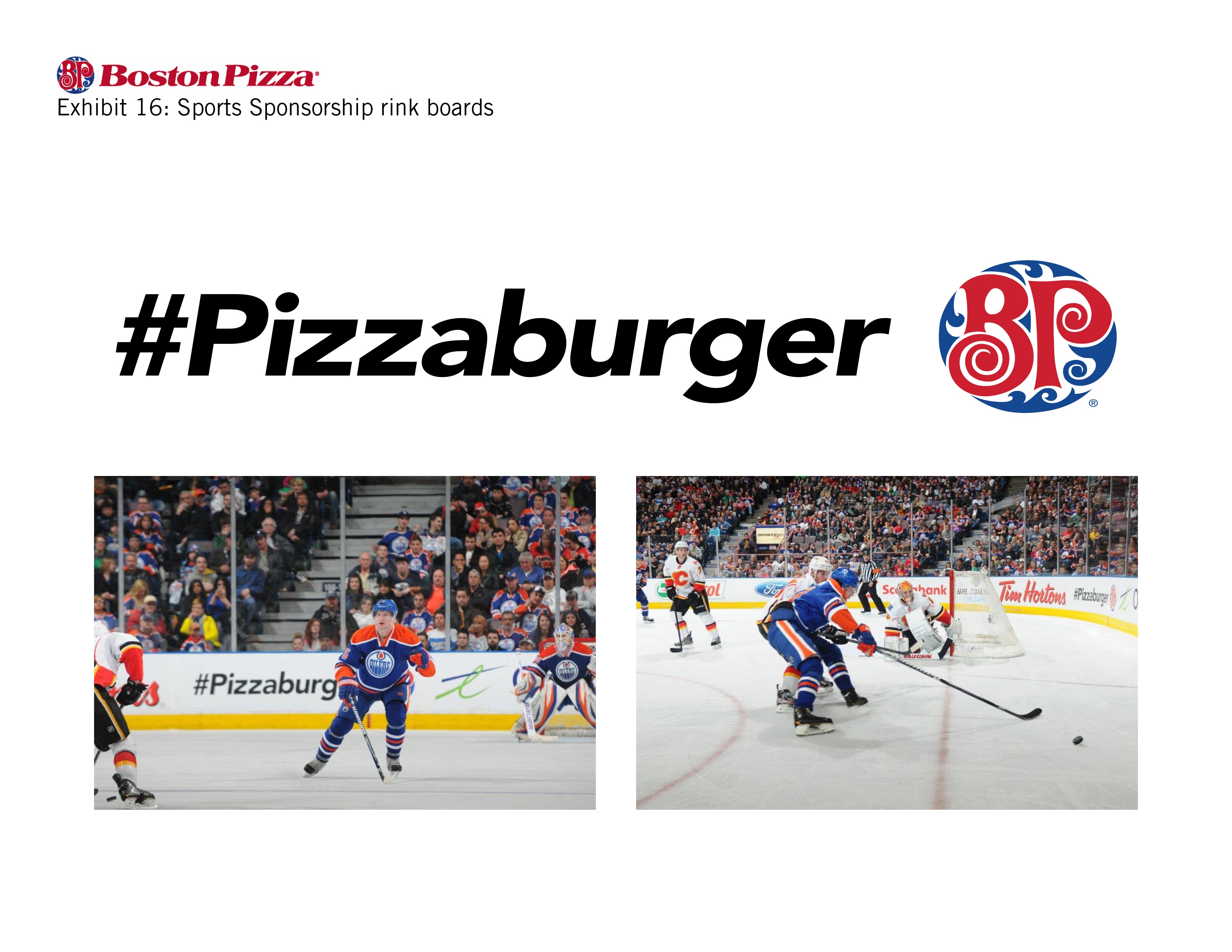
c)Media Discussion
On April 8, 2013, the Pizzaburger campaign launched with a 60-second and a 30-second TV spot that ran during the first week. The 30- and 15-second spots continued to run until June. The TV ads were dedicated to the NHL playoffs schedule to ensure national presence throughout that time frame on TSN and CBC.
Standard IAB banners, along with pre-roll, kicked off the digital activity in April and ran for eight weeks on sports sites, including NHL.com, ESPN, Yahoo Sports, TSN.ca, CBC Sports, Sportsnet, and Score Mobile. Xbox Live was also part of the media buy, launching in tandem with the digital buy.
(Please see Exhibit #17)
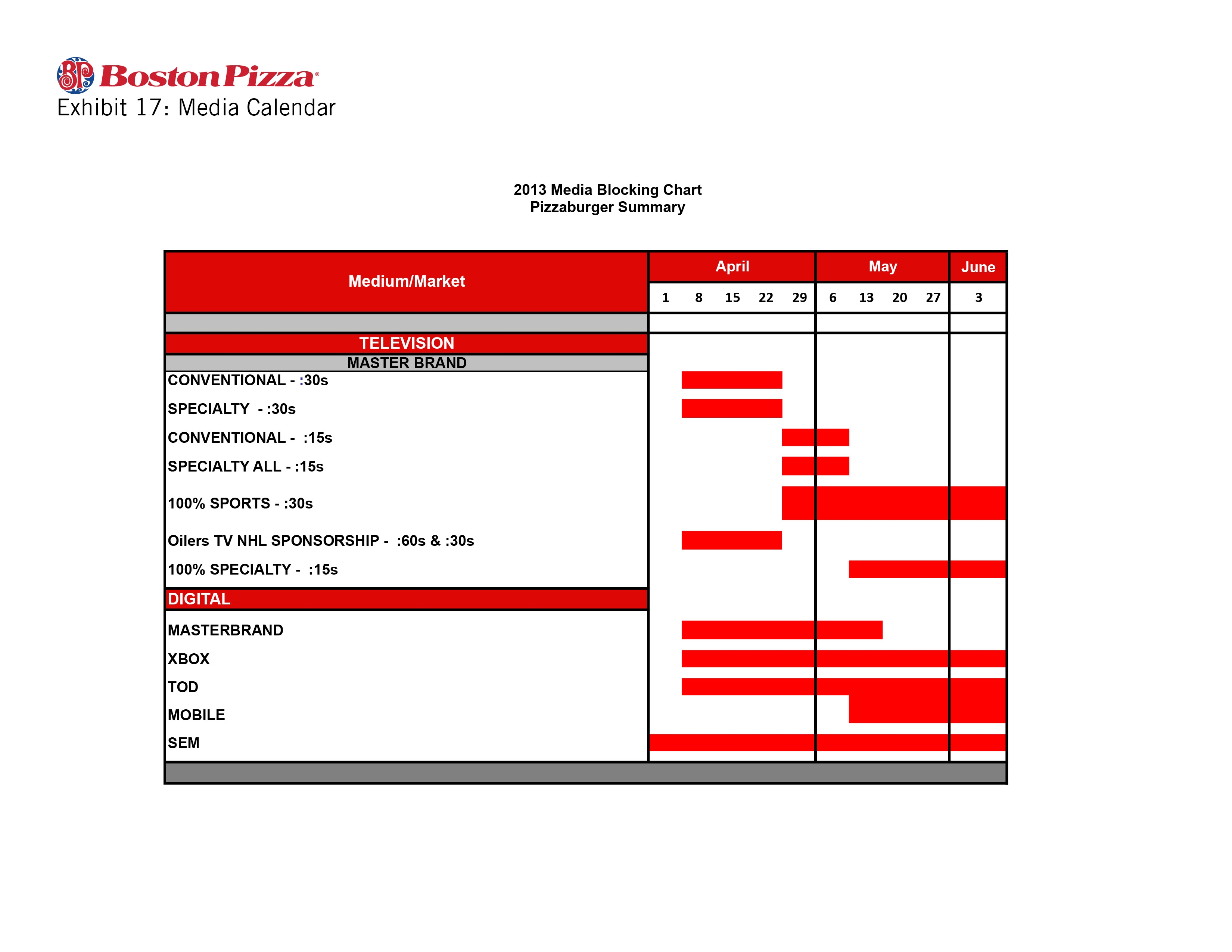
Section V — BUSINESS RESULTS
a) Sales/Share Results
The Pizzaburger has been the most successful product launch in BP’s 49-year history. Within a week of the campaign’s debut, BP’s burger sales leapt to +262.5% versus the previous year. And by the end of the campaign, burger sales were still extraordinarily high +232% higher than the year before. Even better, the launch massively exceeded the goal of 50% growth.
While the Pizzaburger may have come a few hundred (or thousand) years too late to benefit cavemen, Vikings, and knights, now that it’s arrived, it’s here to stay. The Pizzaburger has found a permanent place on BP’s menu and helped continue the momentum of Boston Pizza being seen as the best destination during the NHL playoffs.
b) Consumption/ Usage Results
c) Other Pertinent Results
d) Return on Investment
Section VI — CAUSE & EFFECT BETWEEN ADVERTISING AND RESULTS
a)General Discussion
Boston Pizza submitted the TV creative for Millward Brown testing prior to launch. The test came back with outstanding results. The “awareness index” and “key message” fell into the top 30%, with the “persuasion” and “feel good factor” both hitting above the country’s average. The ad was seen as extremely involving, interesting, and distinctive, indicating that the ad would grab the viewer’s attention from the onset. The interesting premise had left viewers with an overall positive feeling, with most feeling surprised and attracted to the new offering. The intended message of “Boston Pizza has a new Pizzaburger” was heard well above expected levels, as was the notion of Boston Pizza having unique food items. These great results allowed BP to approach the launch with an even stronger sense of confidence.
In addition to the immediate in-restaurant sales, the success of all social media efforts was a relevant indicator of how effective the Pizzaburger campaign was. This campaign showed the power of leveraging restaurant assets. By simply including #pizzaburger on restaurant collateral pieces, we saw over 3,000 organic tweets about the Pizzaburger and over 2,000 pictures on Instagram. The reaction was overwhelmingly positive. All of this was organic conversation, reacting to the in-store collateral pieces.
A true indication that the campaign was successful online was that just one day after the digital media launched, the Pizzaburger became the #1 menu item sold online. It continued to stay on top and was the second most-ordered menu item, next to Boston Pizza’s ALL MEAT WINGS, for the remainder of the month of April.
b)Excluding Other Factors
Spending Levels:
Media spend was on par for this time frame and was consistent with the amount spent in 2012.
Pricing:
Although this year’s burger prices actually increased slightly, Boston Pizza’s guests were not deterred from ordering burgers.
Distribution Changes:
There were no distribution changes made at the time of the campaign. Each franchise operated under the same marketing plan and execution schematic. Geographic coverage remained national in scope, excluding Quebec.
Unusual Promotional Activity:
N/A
Other Potential Causes:
N/A